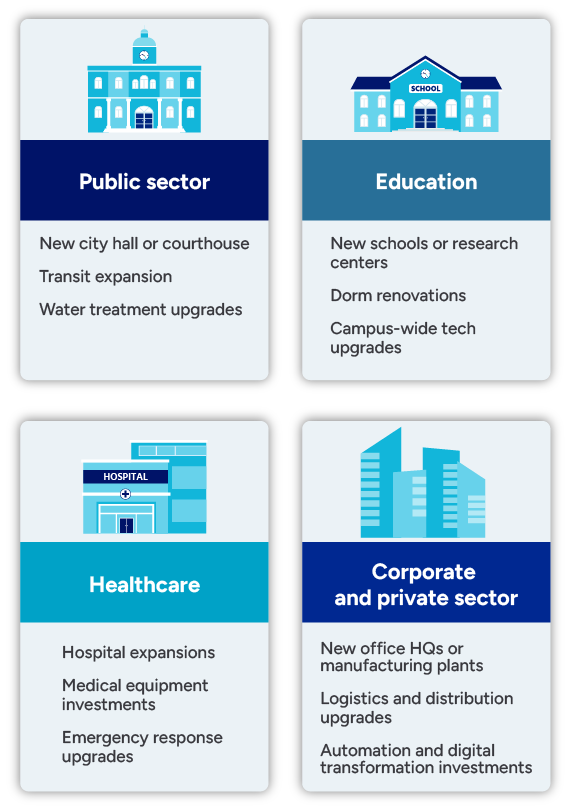Capital Projects

As organizations grow, it’s important that their physical footprint grows along with them. Enter capital projects. Organizations undertake these large-scale investments to improve infrastructure assets, expand facilities, or implement major technological upgrades. The projects are essential for long-term operational success, ensuring that organizations remain competitive and capable of meeting evolving demands. However, capital projects require […]
Table of contents
- What are capital projects?
- Key components of a capital project
- Examples of capital projects
- How capital projects differ from routine maintenance and operational expenses
- Why is capital project management important?
- Challenges in capital project management
- Capital projects in the public sector vs. the private sector
- Capital projects and capital improvement plans
- What are capital projects used for?
- Capital project steps
- Capital project examples
- Benefits of capital projects
- Capital project best practices
As organizations grow, it’s important that their physical footprint grows along with them. Enter capital projects.
Organizations undertake these large-scale investments to improve infrastructure assets, expand facilities, or implement major technological upgrades.
The projects are essential for long-term operational success, ensuring that organizations remain competitive and capable of meeting evolving demands.
However, capital projects require careful planning, significant financial investment, and strategic execution.
Efficient capital planning helps organizations outlay costs from their funding sources. It’s also crucial for executing to minimize delays, control costs, and optimize resources.
Organizations that successfully manage capital projects can improve asset longevity, enhance operational efficiency, and drive economic growth.
However, challenges such as budget constraints, regulatory compliance, and project delays can complicate the process. That’s why organizations must adopt structured planning and management strategies.
What are capital projects?
A capital project is a large-scale investment initiative that creates or improves fixed assets. These assets are typically buildings, infrastructure, and major equipment.
The projects typically require substantial financial resources and long-term planning to ensure successful completion.
Key components of a capital project
Capital projects are complex with many layers. They generally consist of four main phases:
Planning
Planning is a needed part of most initiatives. Capital projects are certainly no exception. To set them in motion, organizations must establish project goals, scope, and feasibility.
Funding
To complete a capital project, an organization must have the funding. How they go about that and the sources of the funds vary based on whether an organization is public or private. Organizations typically use financial resources coming from revenue, grants, loans, or investments. They undergo a significant capital budgeting process to ensure these funds are secured.
Execution
Execution is the action part of a capital project. It’s critical to assign project management professionals to oversee construction, procurement, and implementation.
Evaluation
Like with most initiatives, it’s important to conduct a post-mortem assessment of their success. Capital projects require someone to evaluate the project.
Examples of capital projects
Common types of capital projects include:
- New construction projects (e.g., office buildings, schools, hospitals)
- Infrastructure upgrades (e.g., road expansions, bridge repairs)
- Major renovations (e.g., HVAC system replacements, facility overhauls)
- Technology advancements (e.g., data center expansions, smart building integration)
How capital projects differ from routine maintenance and operational expenses
Routine maintenance is a necessary part of an organization’s operational strategy. It involves regular upkeep and repairs to manage infrastructure assets. While it may improve assets and facilities, it differs from capital projects.
Operational expenses may be included in the same budget as capital projects. However, they are focused on day-to-day costs, including utilities, wages, and supplies. Capital projects represent major expenditures that provide long-term value.
Capital projects
Capital projects involve large-scale, long-term investments. These efforts significantly alter an organization’s physical assets and require multi-year planning, complex budgeting, and extensive regulatory approvals. Examples include:
- Constructing a new headquarters
- Replacing an aging bridge
- Upgrading an entire HVAC system
Routine maintenance
Routine maintenance ensures the functionality and efficiency of existing facilities. Unlike capital projects, these tasks occur regularly and do not involve major structural changes. Examples include:
- Replacing air filters
- Fixing minor plumbing issues
- Repainting interior walls
Take the next step on capital planning with our upcoming webinar
Join us on October 21 as we discuss how to better align maintenance and capital planning efforts to make smarter, data-driven decisions.
Why is capital project management important?
Capital projects command significant investment. Organizations must secure funding either as a result of their own operation or from outside sources. Regardless of where these funds come from, employees must attempt to maximize return on investment. The best way to do that is to adhere to capital project management principles. With those, you can expect:
Improved budget planning
Effective capital project management helps organizations allocate financial resources wisely, preventing unexpected cost overruns and ensuring project sustainability.
Effective resource allocation
By strategically managing personnel, materials, and timelines, organizations can optimize efficiency and reduce waste throughout the project lifecycle.
Better execution
Structured project management leads to timely completion, reduced disruptions, and improved overall project outcomes.
Challenges in capital project management
Capital projects carry significant challenges. Their management does as well. Despite the benefits they bring, organizations often face several challenges when managing capital projects:
Budget constraints
Limited funding can delay or restrict project scope. It’s critically important to utilize the latest resources to maximize budgets and create the transparency needed to keep the project on track.
Aging infrastructure
Many projects involve upgrading outdated systems, requiring extensive planning. Older infrastructure is inherently more difficult to upgrade or replace than new assets. It’s important to use leading industry tools to ensure plans follow best practices.
Regulatory compliance
Typically, these types of construction or improvements require adhering to government standards. With the latest tech stack, your organization can ensure the project is compliant.
Project delays and cost overruns
Unexpected issues such as labor shortages, material costs, and design changes can lead to inefficiencies. However, by integrating the latest tools, organizations can manage the projects more efficiently.
Capital projects in the public sector vs. the private sector
As with many parts of conducting operations, there are differences between the public and private sectors. These projects are no exception. Here are some ways in which they differ:
Public sector capital projects
- Funding sources—Tax revenues, municipal bonds, government grants
- Project focus—Public infrastructure, schools, hospitals, utilities
- Regulatory oversight—Subject to strict procurement and accountability standards
Private sector capital projects
- Funding sources—Private investments, bank loans, revenue
- Project focus—Commercial real estate, industrial expansions, technology upgrades
- Regulatory oversight—Fewer constraints but still subject to industry-specific regulations
Capital projects and capital improvement plans
Despite capital projects and capital improvement plans being different, they are sometimes used interchangeably. There are overlaps between the two but distinct differences. Here are a few:
Capital projects
These involve planning, funding, and executing large-scale investments such as new construction or infrastructure upgrades.
Examples:
- Constructing a municipal building
- Installing a state-of-the-art HVAC system
- Expanding a university’s research facilities
Capital improvement plans (CIPs)
CIPs are multi-year strategic plans that outline future capital projects based on funding availability and organizational goals.
Examples:
- A 10-year city infrastructure improvement plan
- A 5-year hospital expansion strategy
What are capital projects used for?
Capital projects help organizations scale their operations to meet growing or evolving demands. They typically fall into several strategic buckets including:
Infrastructure development
Infrastructure upgrades or new construction is likely the most commonly thought of type of capital project. They include the development of roads, bridges, water treatment plants, etc.
Facility expansion
Facilities house operations, and upgrades are often necessary for growth. Examples of capital projects include new office spaces, school buildings, hospital wings, etc.
Technology upgrades
Large-scale technology implementation requires capital projects and planning. Incorporating smart buildings, digital infrastructure, automated systems are common capital projects.

Capital project steps
To enact a capital project, there are several steps organizations must take. For best practice, capital projects require the following steps:
Assess needs and feasibility
- Conduct infrastructure evaluations
- Perform cost-benefit analyses
Secure funding
- Identify financing sources (grants, loans, internal budgets)
- Align funding with long-term financial plans
Design and plan
- Develop engineering plans and specifications
- Obtain permits and regulatory approvals
Procure and construct
- Select contractors through competitive bidding
- Manage construction schedules and quality control
Monitor and maintain
- Implement asset management strategies
- Conduct regular inspections and preventive maintenance
Capital project examples
To further illustrate how capital projects apply across sectors, here are a few examples from various verticals.
Public sector
- Building a new city hall
- Expanding public transportation
- Upgrading water treatment plants
Education
- Constructing new university research centers
- Renovating student dormitories
- Implementing large-scale technology upgrades
Healthcare
- Developing new hospital wings
- Investing in advanced medical equipment
- Expanding emergency response infrastructure
Corporate and private sector
- Constructing new headquarters
- Upgrading logistics and distribution centers
- Investing in automation and AI-driven technology
Benefits of capital projects
Capital projects do more than just upgrade facilities—they boost efficiency, increase asset value, improve employee satisfaction, and help organizations stay on track with long-term goals. Ultimately, they create stronger organizations. Here’s how:
Infrastructure reliability
Infrastructure is critical for municipalities. Large-scale upgrades strengthen essential public goods for long-term use and population growth.
Economic growth
Capital projects benefit organizations by creating future economic growth opportunities. They also offer short-term construction jobs for third parties.
Improved service delivery
Capital projects enable organizations to provide their products and services better. Whether that is a municipality repaving roadways or a private corporation implementing new machinery to increase productivity, capital projects provide better outcomes for end-users.
Capital project best practices
Before implementing a capital project, it’s important to consider best practices. Organizations undertaking these initiatives need to ensure they:
Align projects with organizational goals
Before making a large-scale capital investment, it’s important to revisit organizational goals. This ensures investments support strategic initiatives.
Leverage data-driven decision-making
Data is the backbone of successful organizations. It is essential to leverage it to make capital project decisions. Use things like facility assessments as well as capital budgeting and planning models to prioritize projects.
Collaborate cross-functionally
To successfully implement a capital project, organizations must utilize several departments. This requires financial professionals, operations professionals, facilities professionals, and construction outfits. Before embarking on a capital project, it’s important to improve cross-departmental communication and stakeholder engagement.
Utilize capital planning software
Capital planning software is a must-have for implementing a capital project. These digital tools streamline budgeting, execution, and oversight.
Summary
Capital projects boost organizational growth, improve infrastructure, and aid operational efficiency. By leveraging capital planning software and strategic decision-making, organizations can optimize their capital investments and maximize long-term benefits.
For more insights on capital improvements and planning, explore these additional resources.
What You Need to Know About Capital Improvement
What is a Capital Improvement Plan?
Preparing a Capital Improvement Plan in 4 Easy Steps